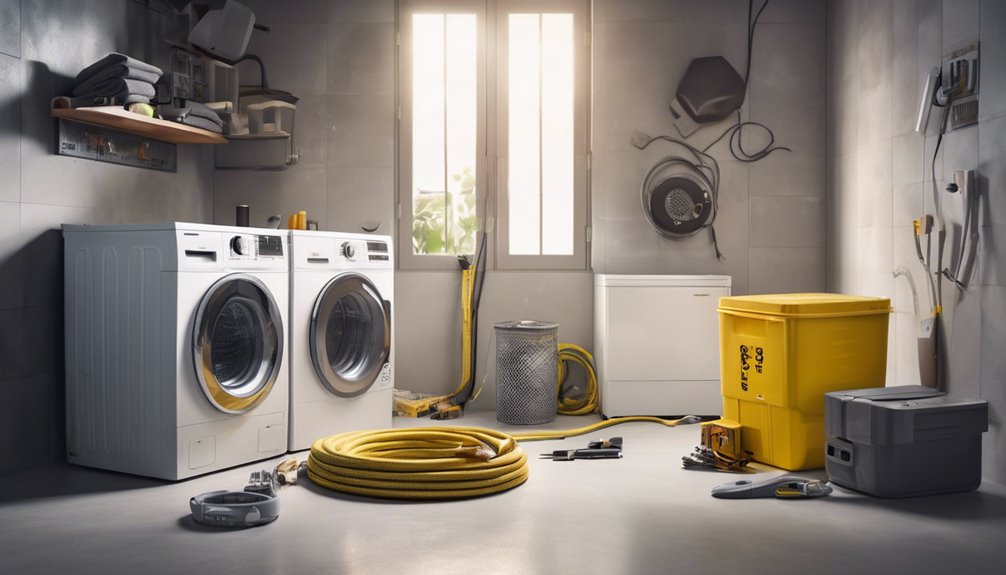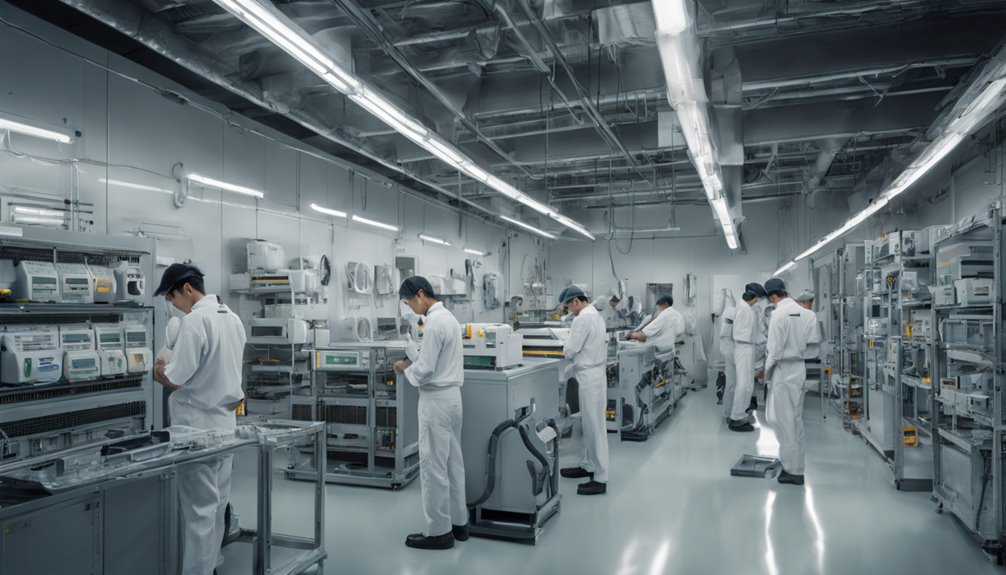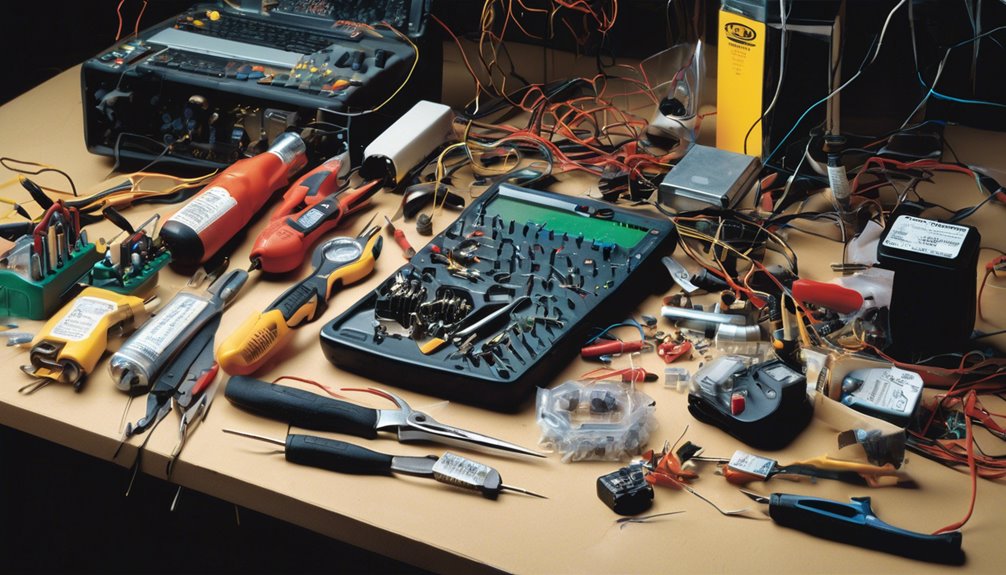When it comes to fixing your air conditioner, knowing where to start can mean the difference between saving money and staying cool or getting stuck with a costly repair bill and a sweltering living space. Start by checking for common issues like air leaks, faulty sensors, and frozen coils, and make sure your thermostat is calibrated correctly. Clean and maintain your AC regularly, and know when to replace parts like air filters and capacitors. With these basics down, you'll be well on your way to tackling DIY repairs – and if you continue, you'll discover even more tips and tricks to keep your AC running smoothly.
Key Takeaways
- Identify common AC problems like air leaks, faulty sensors, and frozen coils to troubleshoot and fix issues efficiently.
- Inspect electrical components like wires, compressors, and capacitors for signs of wear, damage, or corrosion to ensure safe repairs.
- Regularly clean and maintain AC systems by replacing air filters, cleaning coils, and inspecting drain pans to improve efficiency.
- Know when to call a professional for complex issues, emergency situations, or warranty considerations to avoid further damage.
- Always turn off power to the AC unit before starting any replacement work to ensure safety and prevent electrical shock.
Identifying Common AC Problems
When your air conditioner breaks down, it can be frustrating and uncomfortable, especially during the hot summer months.
To get it up and running again, you need to identify the problem. One common issue is air leaks, which can cause your AC to work harder and increase your energy bills. Check your ducts and vents for any gaps or cracks, and seal them with caulk or tape.
Another problem could be faulty sensors, which can prevent your AC from cooling properly. Check the sensor's location and make sure it's not blocked by furniture or curtains.
If you're still unsure, consider consulting your owner's manual or contacting a professional for assistance. By identifying and addressing these common problems, you can get your AC running efficiently again.
Troubleshooting Frozen Coils and Leaks
Frozen coils and refrigerant leaks are two common AC issues that can cause your system to malfunction or even shut down entirely. You can troubleshoot these problems by performing a coil inspection and leak detection. Start by turning off the power to your AC unit and inspecting the coils for signs of frost or ice buildup. Check the refrigerant lines for signs of leaks, such as oil spots or hissing sounds.
| Symptom | Cause |
|---|---|
| Frozen coils | Low airflow or refrigerant leaks |
| Refrigerant leaks | Damaged or worn-out seals or gaskets |
| Hissing sounds | Refrigerant escaping from leaks |
| Oil spots | Refrigerant leaks or worn-out seals |
| Ice buildup | Clogged air filters or low refrigerant levels |
Remember to always follow safety precautions when working with electrical and refrigerant systems. If you're unsure about how to troubleshoot or repair these issues, it's best to consult a professional HVAC technician.
Understanding Your AC's Thermostat
Now that you've checked your AC's coils and refrigerant lines, it's time to focus on the brain of your cooling system: the thermostat.
This device regulates the temperature in your home, so it's crucial to understand how it works.
First, ensure your thermostat is properly calibrated to provide accurate temperature readings. You can do this by checking the thermostat's temperature against a separate thermometer.
Next, evaluate the thermostat's placement in your home. It should be installed away from direct sunlight, appliances, and air vents to prevent inaccurate readings.
Proper thermostat calibration and placement can significantly impact your AC's performance and energy efficiency. By getting these elements right, you'll be able to enjoy a cooler, more comfortable home while saving on your energy bills.
Electrical Components 101
As you delve deeper into the inner workings of your AC, it's essential to familiarize yourself with its electrical components, which play a vital role in powering the entire system.
You'll need to understand circuit analysis to identify issues and perform repairs. Start by identifying the main electrical components, such as the compressor, fan motor, and capacitor.
Next, inspect the wires for signs of wear, damage, or corrosion. Wire inspection is critical to ensure safe and efficient operation.
Look for frayed or exposed wires, and check for loose connections. By understanding these electrical components and performing regular inspections, you'll be better equipped to diagnose and repair common issues with your AC.
Cleaning and Maintaining Your AC
You'll be surprised at how much a little maintenance can go a long way in keeping your AC running smoothly.
Regular checks of your air filter, coil cleaning, and ensuring proper drainage can prevent common issues and even reduce your energy bills.
Air Filter Check
Dirty air filters are a common culprit behind inefficient AC performance, and checking them regularly can make a significant difference.
You'll be surprised at how often dirty filters are overlooked, leading to increased energy bills and reduced airflow. When you check your air filter, look for signs of dirt, dust, and debris accumulation.
If it's dirty, replace it with a new one. Consider upgrading to a high-efficiency filter for better performance. Filter upgrades can also help reduce allergens and pet dander in your home.
Remember to check your filter every 1-3 months, depending on usage and manufacturer's instructions. By keeping your air filter clean, you'll breathe easier and enjoy a more efficient AC performance.
Coil Cleaning Tips
Now that your air filter is clean, it's time to tackle another key component of your AC system: the coils.
Dirty coils can increase your energy bills and reduce airflow, so it's essential to keep them clean.
Start by turning off the power to your AC unit, then locate the coils. You'll typically find them outside, usually on the top or side of the unit.
- Use a garden hose to gently spray the coils, working from the top down to avoid pushing dirt and debris further into the coils.
- Mix baking soda and water to create a paste, and apply it to any heavily soiled areas.
- Let the paste sit for 30 minutes before rinsing it off with the hose.
- Use a soft-bristled brush to gently scrub away any remaining dirt or debris.
Perform a coil inspection regularly as part of your coil maintenance to ensure your AC runs efficiently.
Drainage Maintenance
The condensate drainage system plays a crucial role in your AC's operation, as it helps remove excess moisture from the air.
You should regularly inspect and clean the drain pan to prevent condensate issues. Check the pan for any blockages, dirt, or debris that might be hindering the drainage process.
Clean the pan with a mixture of warm water and soap, and make sure to dry it thoroughly to prevent water spots.
Clogged drain pans can lead to water damage, mold growth, and even AC failure.
By performing regular drain pan cleaning, you'll ensure your AC operates efficiently and effectively.
Replacing Air Filters and Capacitors
You're likely aware that your AC's air filters and capacitors need regular attention to keep your unit running smoothly.
Now it's time to get into the nitty-gritty of replacing these crucial components, starting with the importance of choosing high-quality filters that won't compromise your AC's performance.
Filter Quality Matters
Quality air filters play a crucial role in maintaining your AC's performance and air quality.
You mightn't think about them often, but filters can significantly impact your system's efficiency and the air you breathe.
When choosing a filter, you'll come across different types, such as HEPA, pleated, and electrostatic. Each has its own filter ratings, like MERV, which measures its ability to capture particles.
- Look for filters with a high MERV rating (11-13) for better air quality
- Consider filters with an anti-microbial coating to reduce germ growth
- Check the filter's airflow resistance to ensure it doesn't restrict airflow
- Choose filters with a longer lifespan (3-6 months) to reduce replacement frequency
- Consider upgrading to a smart filter that tracks its own performance and alerts you when it needs replacement
Capacitor Failure Signs
Your AC's capacitor is a crucial component that helps power the compressor and fan motor. Over time, it can deteriorate, causing your AC to malfunction. To avoid this, it's essential to recognize the signs of capacitor failure.
| Symptom | Description | What to Do |
|---|---|---|
| AC Won't Turn On | No power to compressor or fan motor | Check capacitor for signs of damage or aging |
| Reduced Airflow | Weak or intermittent airflow | Inspect capacitor for signs of wear or corrosion |
| Increased Energy Bills | AC working harder to cool | Consider replacing capacitor to improve efficiency |
| Burning Smell | Capacitor overheating or failing | Turn off AC and call a professional for assistance |
Regular capacitor inspection can help identify potential issues before they become major problems. Be on the lookout for signs of capacitor aging, such as bulging, rust, or corrosion.
Replacement Best Practices
Replacing air filters and capacitors is a crucial part of AC maintenance, as faulty or worn-out components can lead to reduced efficiency, increased energy bills, and even system breakdowns.
You'll want to replace them regularly to ensure your AC runs smoothly.
- Check your air filter every 1-2 months and replace it if it's dirty or clogged.
- When replacing a capacitor, make sure to purchase one with the same specifications as the old one.
- If you notice damaged wiring, it's best to call a professional to avoid any safety risks.
- Installing a new compressor can be a complex task, so consider hiring a professional if you're not experienced.
- Remember to turn off the power to your AC unit before starting any replacement work to avoid electrical shock.
Safety Precautions for DIY Repairs
When tackling DIY AC repairs, it's crucial to prioritize your safety above all else. You're dealing with electrical and mechanical components that can be hazardous if not handled properly. Before starting the repair, perform ventilation checks to ensure good airflow in the workspace. This will help prevent the buildup of toxic fumes or debris.
Here's a checklist of safety gear essentials you should have:
| Safety Gear | Description | Importance |
|---|---|---|
| Gloves | Protect your hands from sharp objects and electrical shock | High |
| Safety glasses | Shield your eyes from debris and chemical splashes | High |
| Face mask | Filter out airborne contaminants and dust | Medium |
| Steel-toed shoes | Prevent foot injuries from heavy objects | High |
| Multimeter | Safely measure electrical voltage and current | High |
When to Call a Professional
While DIY AC repairs can be a cost-effective solution, there are situations where it's better to call in a professional.
You shouldn't hesitate to call for help in emergency situations, such as when your AC unit is leaking water or making strange noises.
Additionally, if you're experiencing high bills despite regular maintenance, it may be worth consulting a pro to identify the underlying issue.
- You're not comfortable with DIY repairs or don't have the necessary skills
- You're dealing with complex issues like refrigerant leaks or electrical problems
- Your AC unit is still under warranty and you want to avoid voiding it
- You've tried DIY repairs but the issue persists
- You're short on time and need a quick solution to get your AC up and running again
Frequently Asked Questions
Can I Use a Dehumidifier to Cool My Home Instead of AC?
You're wondering if a dehumidifier can cool your home instead of AC? While it won't chill the air, it can make you feel cooler by removing excess moisture, making it a smart alternative for energy efficiency in humid climates.
How Often Should I Check My Ac's Refrigerant Levels?
You should check your AC's refrigerant levels regularly to avoid costly repairs, as refrigerant leaks can lead to system failures. Schedule annual Freon checks with a pro to ensure your unit's running efficiently and safely.
Can I Use a Regular Vacuum to Clean My Ac's Vents?
You shouldn't use a regular vacuum to clean your AC's vents, as it can push dust accumulation further in. Instead, invest in a vent cleaning brush or a specialized vacuum for proper vent maintenance.
Will a New AC Increase My Home's Resale Value?
When you upgrade to a new AC, you'll boost your home's energy efficiency, which can lead to a higher property appraisal value. In fact, you can expect a significant increase in resale value, making your home more attractive to potential buyers.
Can I Repair My Ac's Compressor Myself?
You're wondering if you can repair your AC's compressor yourself. While DIY troubleshooting is possible, compressor replacement is a complex task that requires professional expertise, so it's best to leave it to a licensed technician to avoid further damage.
Conclusion
You've made it to the end of this AC repair crash course! By now, you're equipped with the basics to tackle common issues, troubleshoot problems, and maintain your unit. Remember to stay safe, replace filters and capacitors regularly, and know when to call a pro. With these tips, you'll be breathing easy in no time. Keep your cool, and happy DIY-ing!



